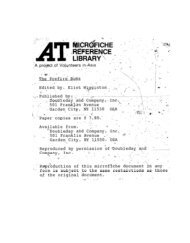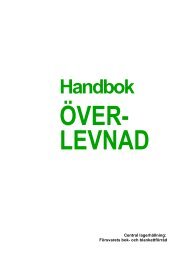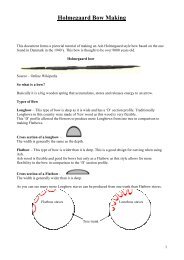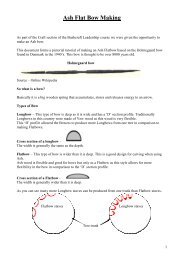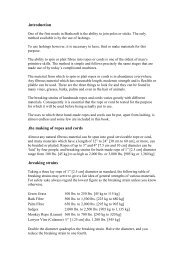Experiments on Knife Sharpening John D. Verhoeven ... - BushcraftUK
Experiments on Knife Sharpening John D. Verhoeven ... - BushcraftUK
Experiments on Knife Sharpening John D. Verhoeven ... - BushcraftUK
Create successful ePaper yourself
Turn your PDF publications into a flip-book with our unique Google optimized e-Paper software.
6 When the 2β edge angle is reduced it becomes more difficult to maintain edge quality.<str<strong>on</strong>g>Experiments</str<strong>on</strong>g> were d<strong>on</strong>e at 2β edge angles of 20 and 40 degrees and the burs formed <strong>on</strong>the as-ground blades were larger for the 20 degree blades. After final polishing <strong>on</strong>leather the waterst<strong>on</strong>e prepared blades produced equivalent edge quality for both edgeangles. However, the 20 degree blades prepared <strong>on</strong> 220 grit oxide wheels compared tothe waterst<strong>on</strong>e prepared blades had slightly rougher edges and less straight edges, inadditi<strong>on</strong> to the increased edge width of c<strong>on</strong>clusi<strong>on</strong> 3.7 It is possible when sharpening <strong>on</strong> either ceramic st<strong>on</strong>es or waterst<strong>on</strong>es to move theedge of the knife either into the cutting edge, I, or away from the cutting edge, A, see Fig.3. Bur forming mechanisms are discussed <strong>on</strong> page 3 and it is c<strong>on</strong>cluded that the using theI directi<strong>on</strong> should produce smaller burs. Hand grinding experiments <strong>on</strong> waterst<strong>on</strong>es (Fig27) found that grinding in the I directi<strong>on</strong> did produce less burring than the A directi<strong>on</strong>,and therefore all grinding <strong>on</strong> st<strong>on</strong>es in this study were d<strong>on</strong>e in the I directi<strong>on</strong>. However,<strong>on</strong> compound loaded soft media, such as leather and buffing wheels, polishing must be inthe A directi<strong>on</strong>.8 Final h<strong>on</strong>ing <strong>on</strong> 1200 grit diam<strong>on</strong>d having the diam<strong>on</strong>d embedded in a nickel matrix<strong>on</strong> a steel plate produced surprisingly large surface abrasi<strong>on</strong> marks, see Fig. 29.9 The special 1000 grit wheels supplied with the Tru H<strong>on</strong>e machine produced edgesnearly as good as the leather h<strong>on</strong>ed edges as regards edge straightness, edge roughnessand surface smoothness. The edge widths were significantly higher, however, runningaround 1 micr<strong>on</strong> versus around 0.3 micr<strong>on</strong>s for leather polished surfaces.10 The set of experiments <strong>on</strong> 52100 and 1086 steels at essentially the same hardness asthe studies <strong>on</strong> stainless steels, HRC = 60, showed that the quality of the edges formed <strong>on</strong>these n<strong>on</strong> stainless steels were quite similar to the stainless steel edges.11 A study was d<strong>on</strong>e <strong>on</strong> three carb<strong>on</strong> steels, 52100, 1086 and a genuine Damascus steelthat compared edge quality of blades at hardnesses of HRC = 40 and 60. The HRC = 60blades c<strong>on</strong>sistently produced superior edge quality after grinding <strong>on</strong> ceramic st<strong>on</strong>es andwaterst<strong>on</strong>es.The ability of a knife to easily cut a material is altered significantly if the cuttingacti<strong>on</strong> is changed from a simple pushing acti<strong>on</strong>, as employed in shaving, to a back-andforthsawing acti<strong>on</strong>, as employed with serrated knives. The bur formed by grindingst<strong>on</strong>es does produce a rough edge <strong>on</strong> the microscale and may reduce the required cuttingforce for some sawing type cutting operati<strong>on</strong>s. However, the bur produces a substantialincrease in the edge width and for cutting acti<strong>on</strong> involving a minimum of sawing moti<strong>on</strong>the bur well be detrimental. The author is not aware of any study that has addressed thisquesti<strong>on</strong> of when, or if ever, a burred edge might be superior for cutting. This study hasbeen directed at the best way to remove as-ground burs.45



